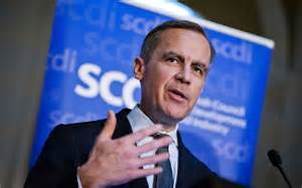Eric Chester (RCN) outlines some of the problems that the SNP government’s White Paper Independence-Lite proposals would pose for genuine Scottish self-determination.

Matin Carney, Governor of the Bank of England outlines Scotland’s future financial and fiscal subjection under sterling
As the referendum campaign unfolds, it becomes increasingly obvious that Alex Salmond and the SNP have no interest in a truly independent Scotland. Instead, a ‘yes’ vote is a vote to authorize Salmond to engage in a series of confidential negotiations that will strip an allegedly ‘independent’ Scotland of much of its powers, while binding it as a subordinate entity to the UK, the United States and the European Union. This underlying reality has become even clearer after the recent debates concerning the sterling zone and the Bank of England.
The SNP has stated from the start that it was intent on keeping Scotland in the sterling zone. Its summary rejection of an independent Scottish currency says a great deal about its confidence in an independent Scotland. Until now the issue has been left otherwise undefined, and the ramifications of this arrangement have been left nebulous. Since the recent speech of Martin Carney, the governor of the Bank of England, we know that the only way that Scotland can remain in the sterling zone is if it agrees to align its fiscal policies with that of Westminster.
The experience of the Eurozone has demonstrated that membership in a currency union carries with it a considerable loss of sovereignty. Countries such as Spain, Greece and Ireland have lost the ability to determine their own social and economic policies, as the European Union has imposed detailed and draconian austerity plans on the governments of these countries. The result has been massive unemployment and the disintegration of essential social services. Carney’s speech is interesting in that he specifies that Westminster would have to agree to a specific procedure that would require the government of an independent Scotland to gain the approval of the British government for its budget and fiscal policies. Without such an understanding in place, the Bank of England would not agree to Scotland remaining within the sterling zone.
Obviously, this leaves a supposedly independent Scotland still dependent on the British government. It thus undercuts a primary argument advanced for a ‘yes’ vote, that is that the Scottish people would no longer be saddled with a Tory government. Interestingly, while the Scottish Greens responded to Carney’s speech by suggesting the need to explore the possibility of an independent currency, the SNP remains committed to the British pound.
Of course, the SNP has already conceded a great deal to the UK. The SNP White Paper assumes that an independent Scotland would retain the monarchy. It does not even raise the possibility that a constitutional convention would declare Scotland to be a democratic republic. This is not a purely symbolic issue. The Crown Powers allow Westminster to continue to interfere in the domestic affairs of other countries, a fact demonstrated in Australia in 1975 when Gough Whitlam was replaced as prime minister by the governor general, an official appointed to represent the monarch. Also, the royal family and other aristocrats own large land holdings in Scotland, land that should be transferred into the public domain for the use of all.
Unfortunately, it is not just to the UK that the SNP is ready to concede power. The SNP is committed to bringing Scotland into the European Union, although the EU has made it clear that Scotland would have to apply as a new member, and could not assert the autonomy currently granted to the UK as a founding member. As a minimum, Scotland would have to agree to implement restrictive fiscal policies that limit the national debt, and make it more difficult to pursue expansionary policies to counter the current crisis. In addition, it is highly likely that Scotland would be required to join the Eurozone after a transitional period, a move that would necessitate a further economic integration into the EU, with further rounds of austerity cuts a likely result.
The SNP has heralded the removal of the Trident missiles as a major argument for independence, even proposing a clause in a proposed constitution that would prevent nuclear weapons from being based in an independent Scotland. Yet Salmond pushed the SNP to drop its previous opposition to Scotland’s membership in NATO, although participation in NATO’s nuclear weapons program is a requirement for membership. As a result, the SNP has already quietly agreed that an independent Scotland would follow Denmark’s policy of ‘no ask, no tell.’ Thus the United States and rUK could continue to use Scottish military bases for planes, ships and submarines carrying nuclear weapons, with the Scottish government’s tacit approval. Furthermore, the SNP has agreed to permit Britain to station Trident missiles at Faslane at least through 2020. (Guardian, November 26, 2013.)
Salmond and the SNP are not prepared to confront the powers to be. The SNP vision of a future independent Scotland is one that remains a subordinate component of the existing world order. Pointing to fine sounding phrases in the White Paper can only serve to hide this reality, and make it more difficult to struggle for a genuinely independent Scotland.
For another contribution on the SNP government’s White Paper by Murdo Ritchie see:- Alex Salmond And The Written Constitution
For other contributions to the debate on Scottish self-determination by Eric Chester see:-
hSCOTTISH INDEPENDENCE: SHAM OR GENUINE?
